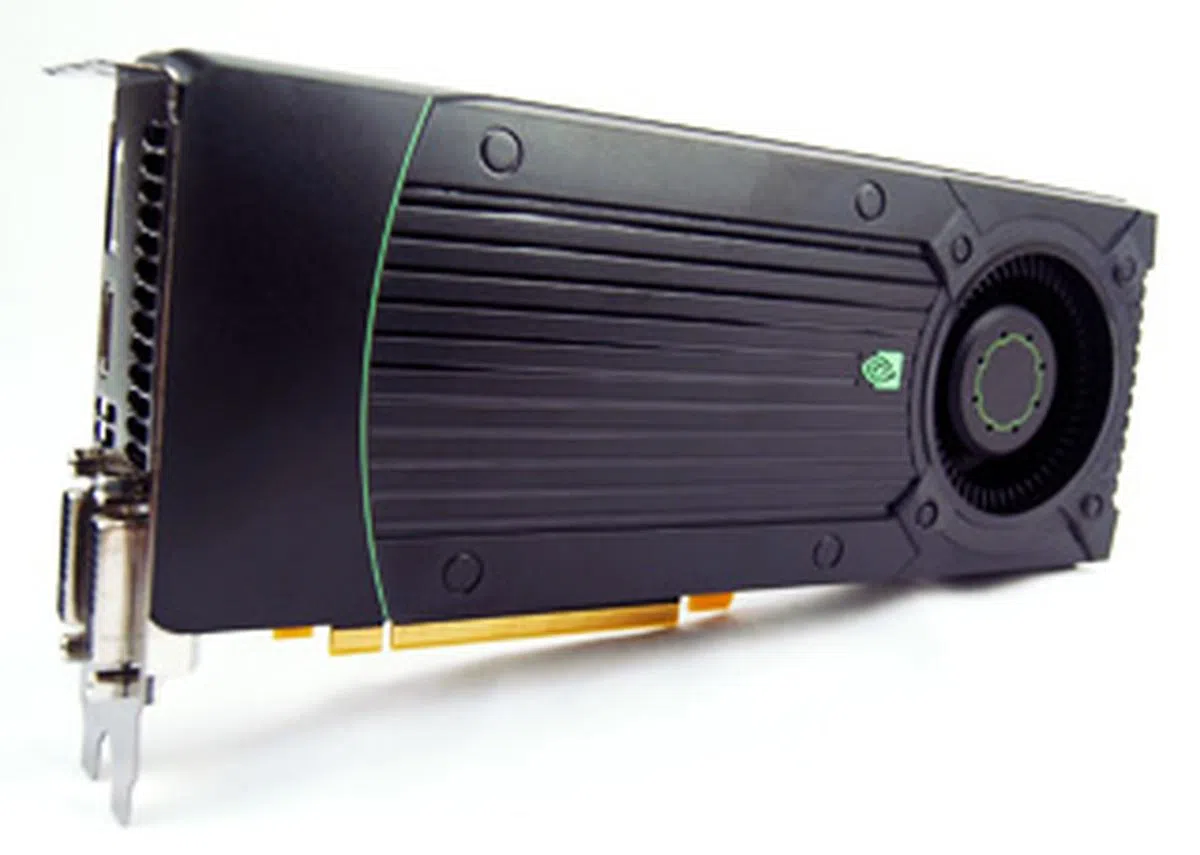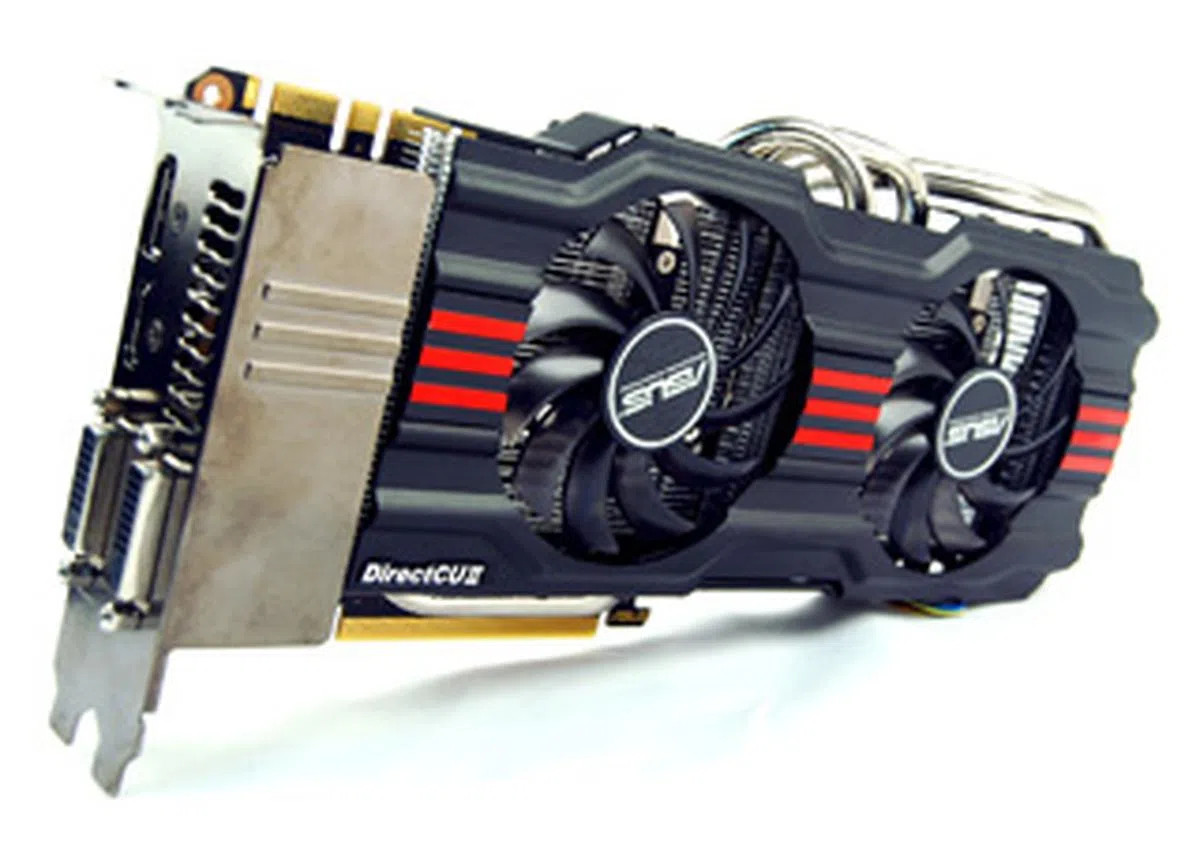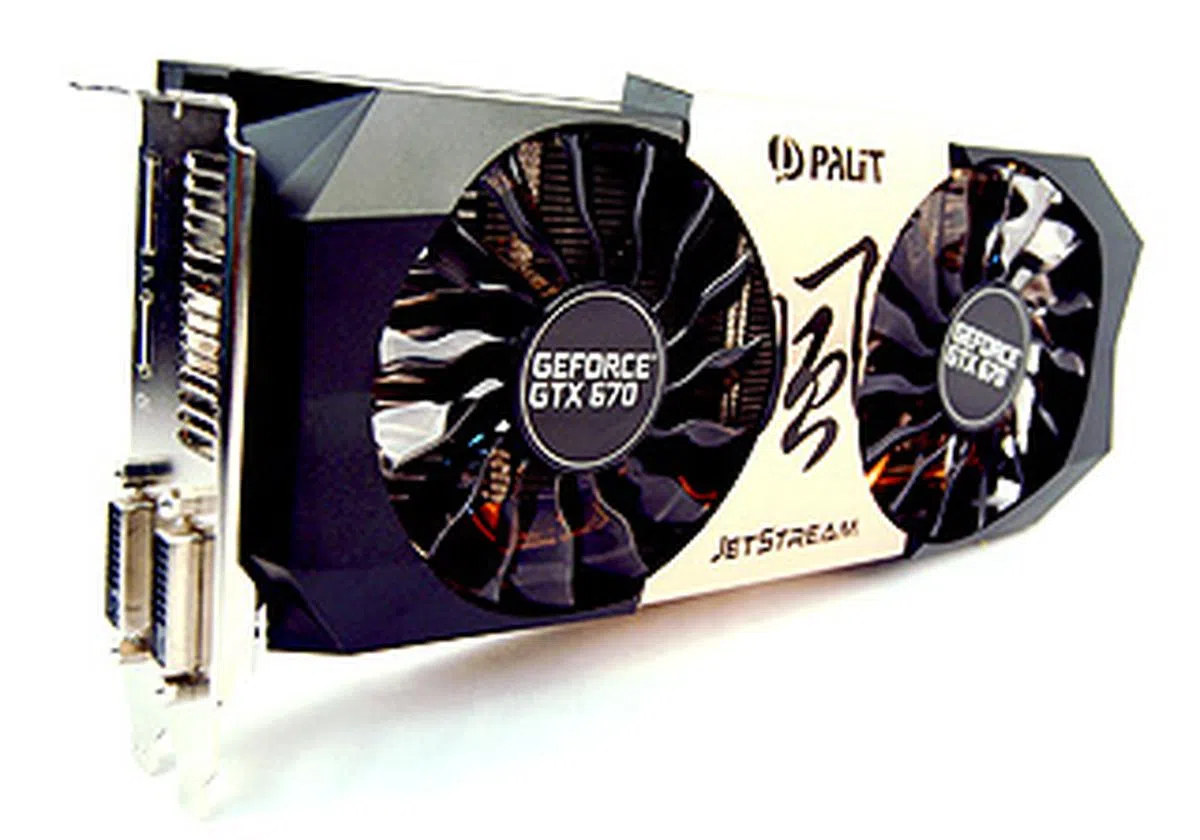NVIDIA GeForce GTX 670 - Gaining Momentum, Building Steam
NVIDIA is building momentum with the all-new GeForce GTX 670. Essentially a cutdown GeForce GTX 680, we check out the reference card as well as two customized ones from ASUS and Palit to see what it brings to the table. High-end graphics card shoppers should be pleased.
By Kenny Yeo -
1344 Cores to the Fore
After a lull period, the two graphics giants - AMD and NVIDIA - have awaken. In early January, AMD fired the first salvo by releasing the Radeon HD 7970, the first of their new Southern Islands cards.
In retaliation, NVIDIA released the GeForce GTX 680 in late March. The new GeForce GTX 680 was a winner in our books, offering superb performance and decent power and thermal characteristics. The guys in green then followed up with the massive dual-GPU GeForce GTX 690, reclaiming the title of fastest single graphics card. And now, with no letup, NVIDIA is following up with the GeForce GTX 670.
Although yields for the fully-enabled GF104 chip has been good, a good number of them have failed to make the cut. And this has enabled NVIDIA to quickly release the GeForce GTX 670, which is essentially a cutdown GeForce GTX 680.

Along with the reference GeForce GTX 670 from NVIDIA, we will also be taking a close look at two customized examples from ASUS and Palit.
The GeForce GTX 670 is based on the same GK104 core that powers the flagship and the two actually share many similarities, but with some crucial differences. For those new to NVIDIA’s latest GeForce cards, it’s best to check out our review of the GeForce GTX 680 first to get up to speed on the improvements and latest technologies that NVIDIA’s latest cards offer.
As for the GeForce GTX 670, for starters, it loses one SMX (Streaming Multiprocessor). This means it has lesser CUDA cores - 1344 as compared to 1536; and also lesser texture mapping units - 112 versus 128. However, because it loses an SMX and not an entire GPC (graphics processing cluster), it still retains the same number of raster operating units - 32 - and also has the same 256-bit wide memory bus interface.
Elsewhere, clock speeds have also gone down to differentiate the GeForce GTX 670 from the flagship GeForce GTX 680. The base clock speed of the GeForce GTX 670 stands at 915 MHz, whereas the typical boost clock provided by GPU Boost, a new dynamic overclocking technology not unlike Intel’s Turbo Boost, is 980MHz. Memory clock speed, however, remains unchanged at a blazing 6008MHz DDR. This means overall memory bandwidth remains the same at 192.3GB/s.
So on paper, the GeForce GTX 670 certainly does look formidable and it’ll be interesting to see how it matches up against the flagship GeForce GTX 680, considering it is priced a whole US$100 lesser at US$399, yet only lacks a single SMX and has slightly lower core clock speeds. More importantly, at US$399, we are eager to find out how it'll match up against its targeted rival, the similarly priced AMD Radeon HD 7950.
In this review we will also be looking at two customized GeForce GTX 670 cards from ASUS and Palit. Both cards are factory-overclocked and sport unique customized coolers, so it will be interesting too to see how these two cards perform against the reference card.
Here’s a quick look at how the GeForce GTX 670 stacks up against its competitors.
Model | NVIDIAGeForce GTX670 | NVIDIA GeForce GTX 680 | AMDRadeon HD 7970 | AMDRadeon HD 7950 | NVIDIA GeForce GTX 580 | AMDRadeon HD6970 |
Core Code | GK104 | GK104 | Tahiti XT | Tahiti Pro | GF110 | Cayman XT |
Transistor Count | 3540 million | 3540 million | 4300 million | 4300 million | 3000 million | 2640 million |
Manufacturing Process | 28nm | 28nm | 28nm | 28nm | 40nm | 40nm |
Core Clock | 915MHz | 1006MHz | 925MHz | 800MHz | 772MHz | 880MHz |
Stream Processors | 1344 Stream processing units | 1536 Stream processing units | 2048 Stream processing units | 1792 Stream processing units | 512 Stream processing units | 1536 Stream processing units |
Stream Processor Clock | 915MHz | 1006MHz | 925MHz | 800MHz | 1544MHz | 880MHz |
Texture Mapping Units (TMU) or Texture Filtering (TF) units | 112 | 128 | 128 | 112 | 64 | 96 |
Raster Operator units (ROP) | 32 | 32 | 32 | 32 | 48 | 32 |
Memory Clock | 6008MHz GDDR5 | 6008MHz GDDR5 | 5500MHz GDDR5 | 5000MHz GDDR5 | 4000MHz GDDR5 | 5500MHz GDDR5 |
DDR Memory Bus | 256-bit | 256-bit | 384-bit | 384-bit | 384-bit | 256-bit |
Memory Bandwidth | 192.3GB/s | 192.3GB/s | 264GB/s | 240GB/s | 192.4GB/s | 176GB/s |
PCI Express Interface | PCIe ver 3.0 x16 | PCIe ver 3.0 x16 | PCIe ver 3.0 x16 | PCIe ver 3.0 x16 | PCIe ver 2.0 x16 | PCIe ver 2.0 x16 |
Molex Power Connectors | 2 x 6-pin | 2 x 6-pin | 1 x 6-pin, 1 x 8-pin | 2 x 6-pin | 1 x 6-pin, 1 x 8-pin | 1 x 6-pin, 1 x 8-pin |
Multi GPU Technology | SLI | SLI | CrossFireX | CrossFireX | SLI | CrossFireX |
DVI Output Support | 2 x Dual-Link | 2 x Dual-Link | 2 x Dual-Link | 2 x Dual-Link | 2 x Dual-Link | 2 x Dual-Link |
HDMI | 1 | 1 | 1 | 1 | 1 (mini-HDMI) | 1 |
DisplayPort | 1 (version 1.2) | 1(version 1.2) | 2 (version 1.2 HBR2) | 2 (version 1.2 HBR2) | None | 2 (version 1.2) |
HDCP Output Support | Yes | Yes | Yes | Yes | Yes | Yes |
Street Price | Launch Price: US$399 | Launch Price: US$499 | ~US$479 | ~US$399 | ~US$509 | ~US$349 |
The NVIDIA GeForce GTX 670
The new reference design GeForce GTX 670 is one of the most compact high-end cards we’ve seen in a long time. The card measure rough 9.5 inches in length - which is already compact considering its high-end positioning. However, what’s more surprising is that the actual PCB itself is only a mere 6.9 inches! The additional space, if you are wondering, is taken by the blower fan and the larger radiator assembly that brings the overall card size to something more normally expected. Judging from the size and build of the reference card, we suspect that the GeForce GTX 670 is pretty lax when it comes to cooling requirements and we think it won’t be long before we see single-slot card designs in the market or perhaps much more compact variants. So keep a look out for those when we bring you coverage from Computex, Taipei this June.

For a high-end graphics card, the GeForce GTX 670 is actually pretty compact, measuring in at around 9.5 inches. This means it'll fit into most casings with ease.

The PCB is actually only 6.9 inches in length. The additional length is due to the cooler, which we found to be quite audible during testing.

In terms of output connectivity, the reference card offers two dual-link DVI ports, a single HDMI port and a single DisplayPort.

The card draws power via two 6-pin PCIe power connectors. TDP is rated at 170W, which is pretty low for a high-end graphics card. NVIDIA recommends a PSU rated for 500W.

Two SLI connectors mean 4-way SLI is possible.
ASUS GTX 670 DirectCU II TOP
DirectCU II is ASUS’ second-generation DirectCU cooler. For the uninitiated, DirectCU is ASUS’ custom cooler technology which has its heat pipes in direct contact with the GPU core instead of a copper base plate with heat pipes running through. This improves heat dissipation by offering a direct outlet for heat to transfer to the heatsink array. However, the implementation of the DirectCU cooler hasn't always been a very positive experience as we last noticed in our Radeon HD 7970 comparison. Hopefully it comes out better this time round, but we'll get to those details in our temperature test segment.
As befits a card that has been bestowed with the TOP suffix, the ASUS GeForce GTX 670 DirectCU II has a couple of tricks up its sleeves. One of which is its 8-phase Super Alloy Power. Compared to the reference card’s 4-phase PWM, the ASUS card has an 8-phase PWM design for better power delivery.
As denoted by the TOP suffix, the card is also factory-overclocked. Base and boost clock speeds have both been bumped up substantially to 1058MHz and 1137MHz respectively. This represents a boost of around 15%. Memory clock speeds have been kept unchanged at 6008MHz DDR.

The ASUS GTX 670 DirectCU II TOP sports the second generation DirectCU II cooler that has heat pipes in contact with the GPU core for more efficient heat dissipation.

The ASUS card has the standard twin DVI ports and single HDMI and DisplayPort.

ASUS has employed their DirectCU II cooler on many cards in the past and on this card, the cooler has no less than five copper heat pipes (two on the other side).
Palit GeForce GTX 670 JetStream
As the card’s name suggests, Palit’s take on the GeForce GTX 670 uses the company’s own JetStream custom cooler. The Palit card retains the reference card’s 9.5-inches length, but is slightly thicker because of its beefy dual-fan custom cooler. As such, it will also occupy 2.5 expansion slots, which could make things a bit tricky for folks thinking of going down the SLI route.
As for clock speeds, the card has slightly boosted base clock speeds of 1006MHz and a higher boost clock speed of 1086MHz. Memory clock speeds have been bumped up to 6108MHz DDR.

Despite the almost comically huge 90mm fans, the Palit GeForce GTX 670 JetStream is still the same length as the reference card.

The Palit card comes with the standard twin DVI ports and single HDMI and DisplayPort.

The character 風 is Chinese for Wind. An apt representation considering its JetStream custom cooler. Cooling duties are handled by two large 90mm fans.

The Palit card's party piece are these blue LED lights. Cool, if you have a see-through casing to show them off.
Test Setup
As usual, the following are the specs of our trusty graphics card test bed system:
- Intel Core i7-975 (3.33GHz)
- Gigabyte GA-EX58-UD4P motherboard
- 3 x 1GB DDR3-1333 G.Skill memory in triple channel mode
- Seagate 7200.10 200GB SATA hard drive
- Windows 7 Ultimate 64-bit
We’ll be pitting the reference GeForce GTX 670 against AMD’s Radeon 7900 series cards, in particular its targeted rival, the Radeon HD 7950. With its bigger brother the GeForce GTX 680 already comprehensively outclassing AMD’s best single GPU cards, it’ll be interesting to see how the new GeForce GTX 670 fares. We also want to find out how the GeForce GTX 670 would match up against the flagship GeForce GTX 680, because judging from the specifications alone, the two do not differ that much. Lastly, as for the two customized cards from ASUS and Palit, we are keen to see how much faster and cooler the two customized GeForce GTX 670 cards would run when compared against the reference GeForce GTX 670.
Here's a summary of the card's clock speeds.
Cards | GPUBase Clock Speed | Boost Clock Speed | Memory Clock Speed |
NVIDIAGeForce GTX670 | 925MHz | 980MHz | 6008MHz DDR |
ASUSGTX 670 DirectCUIITOP | 1058MHz | 1137MHz | 6008MHz DDR |
Palit GeForce GTX 670 JetStream | 1006MHz | 1086MHz | 6108MHz DDR |
The list of cards tested and driver versions used:
- NVIDIA GeForce GTX 680 2GB GDDR5 (ForceWare 301.33)
- ASUS GTX 670 DirectCU II TOP 2GB GDDR5 (ForceWare 301.33)
- Palit GeForce GTX 670 JetStream 2GB GDDR5 (ForceWare 301.33)
- AMD Radeon HD 7970 3GB GDDR5 (AMD Catalyst 12.2 Preview Version)
- AMD Radeon HD 7950 3GB GDDR5 (AMD Catalyst 12.2 Preview Version)
- AMD Radeon HD 6990 4GB GDDR5 (AMD Catalyst 11.11)
- AMD Radeon HD 6970 2GB GDDR5 (AMD Catalyst 11.11)
- NVIDIA GeForce GTX 590 3GB GDDR5 (ForceWare 280.
- NVIDIA GeForce GTX 580 1560MB GDDR5 (ForceWare 280.26)
The list of benchmarks used:
- Futuremark 3DMark 11
- Battlefield: Bad Company 2
- Crysis Warhead
- Far Cry 2
- Crysis 2
- Batman: Arkam City
- Dirt 3
- Unigine v2.1
- S.T.A.L.K.E.R.: Call of Pripyat
3DMark 11 Results
We begin our analysis of the new GeForce GTX 670 with the very popular 3DMark 11 benchmark. The latest iteration of FutureMark’s benchmarking utility makes extensive use of all DirectX 11 features such as tessellation, compute shaders and multi-threading, making it a good gauge of a card’s performance.
The reference GeForce GTX 670 scored 8198 and 2894 3DMarks on the Performance and Extreme preset respectively. These figures completely trounces the Radeon HD 7950’s equivalent score of 6641 and 2247 3DMarks by over 20%. It even managed to edge out the Radeon HD 7970, which scored 7659 and 2689 3DMarks. The flagship GeForce GTX 680 still reigned supreme as far as single GPU cards are concerned.
The two customized GeForce GTX 670 cards from ASUS and Palit both did pretty well, posting higher scores than the reference card from NVIDIA, as expected. The ASUS GTX 670 DirectCU II TOP, in particular, scored even higher than the GeForce GTX 680.

Using EVGA’s PrecisionX overclocking utility, we can clearly see NVIDIA’s GPU Boost technology at work as the card ramped up its speeds whenever the test ran proper, and toned down in the intervals when the tests were loading. More impressively, the card peaked at 1097MHz, more than 100MHz above its default boost clock speed, showing just how adaptive and intelligent GPU Boost technology is.

Battlefield Bad Company 2 Results
Next, we move on to Battlefield Bad Company 2, one of the earliest DirectX 11 first-person shooters. The GeForce GTX 670 turned in a brilliant performance, once again comfortably seeing off its direct competitor, the Radeon HD 7950 by at least 30% across all resolutions. It was even quicker than the Radeon HD 7970 as well, by around 15% overall. Compared to previous generation NVIDIA cards, the GeForce GTX 670 was miles ahead of the GeForce GTX 580 and only slightly off the pace when compared against the dual-GPU GeForce GTX 590.
The two customized cards performed well here as well. The ASUS GTX 670 DirectCU II TOP was marginally quicker, which was to be expected given its slightly higher clock speeds, and was almost on a par with the current single GPU speed king, the GeForce GTX 680.

Here we noticed that the GeForce GTX 670 once again ramped up beyond its default boost clock speed of 980MHz by recording a peak clock speed of 1097MHz. This is yet another clear indication of the effectiveness of NVIDIA’s GPU Boost technology.

Crysis Warhead Results
Even today, Crysis Warhead is still considered a pretty taxing benchmark, but it is running on DirectX 10 and not the de facto standard expected today that is DirectX 11. As such, the Radeons managed to claw their way back somewhat. The GeForce GTX 670 was not as dominant but it was still a smidge quicker than the Radeon HD 7950.
The two customized GeForce GTX 670 performed decently, with the ASUS GTX 670 DirectCU II TOP having the advantage against the Palit GeForce GTX 670 JetStream thanks to its superior clock speeds. Again, we noted that the performance of the ASUS card was comparable to that of the GeForce GTX 680.
 | 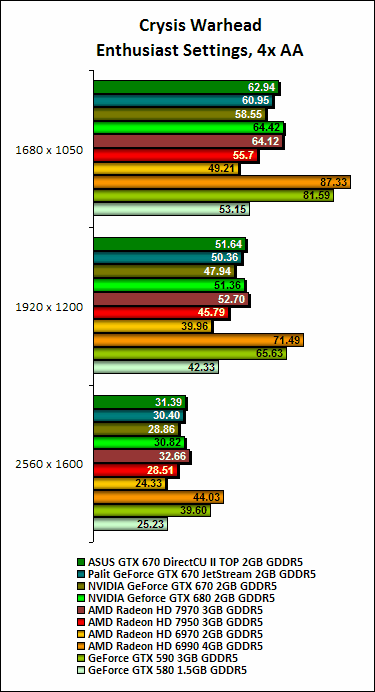 |
Referring to the performance log graph, we can see that the GeForce GTX 670’s core clock speeds being constantly adjusted to give the best performance. Once again, our card managed a peak clock speed of 1097MHz, which is a good 11% beyond its default boost clock speed and close to 20% above its base clock speed.

Far Cry 2 Results
Far Cry 2 saw the GeForce GTX 670 return to its dominant form, thrashing both the Radeon HD 7970 and HD 7950 comfortably. It was quicker than the Radeon HD 7970 by around 10% overall and the Radeon HD 7950 by a whopping 30% on average.
As expected, the two customized cards from ASUS and Palit posted slightly higher frame rates than the reference card, with the ASUS GTX 670 DirectCU II TOP once again managing GeForce GTX 680-levels of performance.
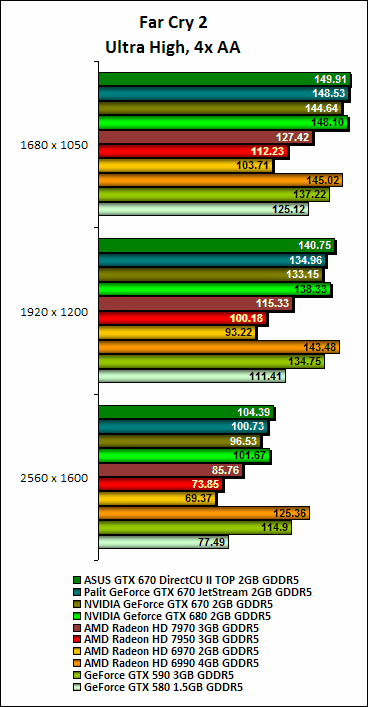 |  |
With GPU Boost at work, our reference GeForce GTX 670 once again recorded a peak core clock speed of 1097MHz. Judging from this and previous benchmarks, this demonstrates the consistency of NVIDIA’s GPU Boost technology.

Crysis 2 Results
Much like its predecessor, Crysis 2 requires a beast of machine to run smoothly at the highest resolutions, and the GeForce GTX 670 achieved pretty impressive results. On a whole it was on a par with the more expensive Radeon HD 7970 and it was easily at least 10% faster than the Radeon HD 7950.
The customized ASUS and Palit card predictably recorded better frame rates than the reference card, with the ASUS card once again impressing with its results which could rival the more costly GeForce GTX 680.

Looking at the performance log for Crysis 2, we can see clearly that the card is running at full tilt when power is at 102% (when the card doesn't power itself down slightly in between runs when the game loads). When the benchmark is commences, the reference card was running at about 1058MHz, well above its rated clock speeds.

Batman: Arkham City Results
On action game Batman: Arkham City, the GeForce GTX 670 easily beat both the Radeon cards by at least 30% overall. Its performance was on a par with the GeForce GTX 680, which is certainly impressive. Again, we noticed that the two customized cards from ASUS and Palit were notably quicker, which was to be expected given their higher clock speeds. Interestingly, at the highest resolution, the two custom designed cards are registering pretty strong results, far more than the GTX 680 itself.
Note that this is a PhysX optimized game and as such the results are squarely in favor of NVIDIA's cards. Still, it's interesting to see what kind of results we can get with a game title optimized with PhysX.

Batman: Arkham City is a pretty intensive benchmark and we noticed that the card adjusted its power draw to a peak of 108%, while once again bumping up its clock speeds to around 1058MHz to offer the best possible performance - all without us ever needing to tweak it.

Dirt 3 Results
Dirt3 was one of the poster boys for DirectX 11 gaming as it was one of the earliest titles to support it. And on this racing game benchmark, the GeForce GTX 670 continued its dominant showing by easily trumping both the Radeon HD 7970 and HD 7950. Against the more powerful Radeon HD 7970, we noticed it was about 12% to 20% quicker; against the Radeon HD 7950, its advantage increased to more than 50%. In fact, the GeForce GTX 670 was about as quick as last generation’s dual GPU cards!
As for the two customized cards, they were marginally quicker than the reference GeForce GTX 670 and on a par with the GeForce GTX 680.

On Dirt 3, our reference card kept a pretty constant clock speed of around 1045MHz, which is well above NVIDIA’s rated boost clock speed of 980MHz. However, we noticed that the card ran pretty warm as well at around 78 degrees Celsius.

Unigine "Heaven" Results
Unigine is a synthetic benchmark that utilizes tessellation heavily, and therefore a good test of a GPU’s ability to handle tessellation - one of the key features supported on the DX11 API that is visibly effective when implemented. The new GeForce 600 series utilizes NVIDIA’s second generation Polymorph engine which promises double the tessellation performance. Here on Unigine, we saw the GeForce GTX 670 dominating its rivals from the red camp. It easily outclassed the Radeon HD 7950 by at least 20% overall and was even as much as 70% quicker in some instances. Even the more powerful Radeon HD 7970 was not its match. We also noticed that the GeForce GTX 670 was faster than the GeForce GTX 680, this could be because of the newer drivers it is running with, as the GeForce GTX 680 was tested with slightly earlier beta drivers. We'll update those results in the near future, but it doesn't change the fact of the GTX 670's performance is really appealing.
Further to that, the customized cards from ASUS and Palit continued their fine performance and they were about 5% to 10% quicker than the reference card.
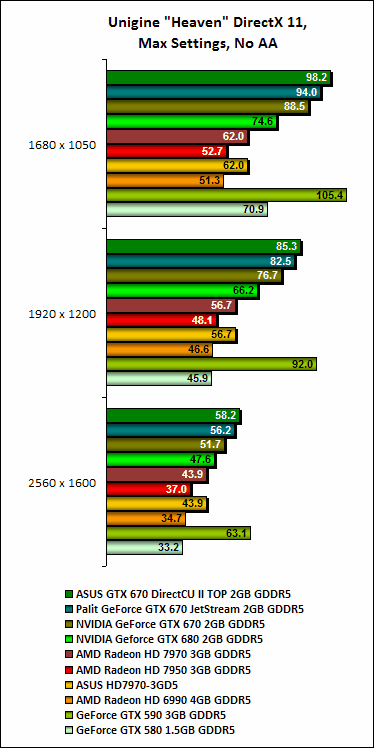 | 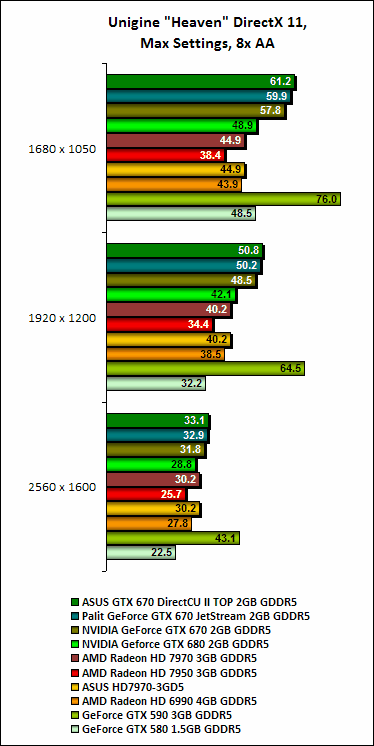 |
On Unigine, our reference card once again managed to maintain a steady boost clock speed of around 1045MHz, well above NVIDIA’s own claims. Power draw was also hovering at around 101% and there were points where it peaked at 108%. Consequently, the card also ran pretty warm recording 78 degrees Celsius.

S.T.A.L.K.E.R.: Call of Pripyat Results
The GeForce GTX 670 continued to outperform the Radeon HD 7950 as it was around 10% to over 20% faster on the Day run. The Radeon HD 7950 managed to claw itself back a tad when it came to the Sunshafts run, but even then, it was still 5% to 10% slower than the GeForce GTX 670. The GeForce GTX 670 was also more than a match for the more costly Radeon HD 7970, losing out only when it came to the more intensive Sunshaft runs. It wasn’t that far behind the flagship GeForce GTX 680 either, as the latter was only about 5% quicker.
As we had expected, the two customized cards from ASUS and Palit were marginally quicker than the reference card, with both recording frame rates that were capable of matching the more expensive GeForce GTX 680.
 | 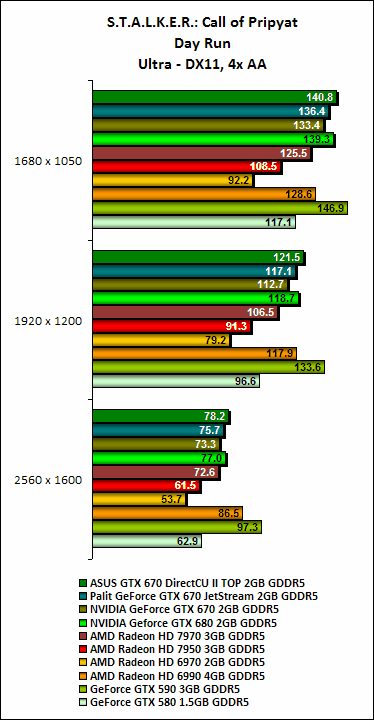 |
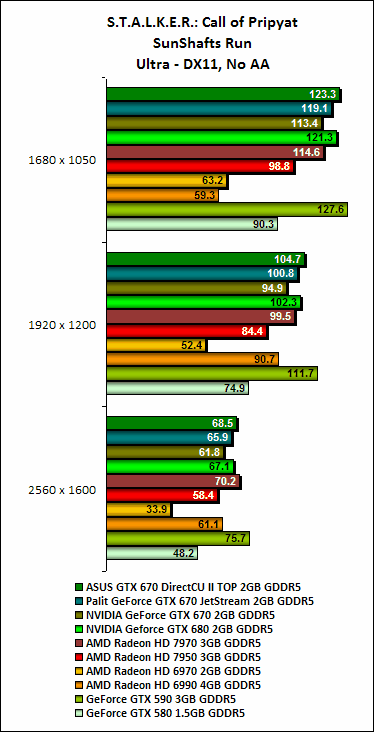 | 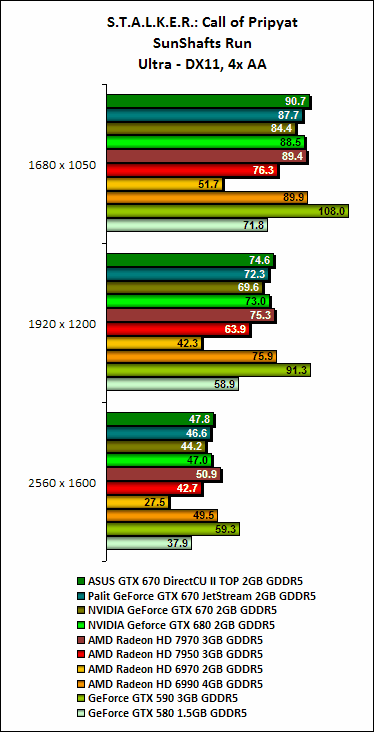 |
Looking at the performance log, we noted that our card once again held a steady core clock speed of 1058MHz. Clearly, GPU Boost is a technology that works well. However, it also means that because no two chips are equal, even between reference GeForce GTX 670 cards, performance will inevitably vary. Still, we don't think it'll vary so much that it would be worth worrying about.

Temperature
The GeForce GTX 670 recorded a maximum sustained temperature of 65 degrees Celsius, which is slightly warmer than its direct rival the Radeon HD 7950. However, considering how much faster it is, we think this is something we could gloss over. Besides, 65 degrees for a high-end card is something unthinkable just a generation ago. To put this in perspective, the GeForce GTX 580 from just a generation ago tipped the scales at 80 degrees Celsius, the GeForce GTX 670 is considerably faster yet much cooler.
Despite their custom coolers, the ASUS and Palit cards weren’t really that much cooler. The Palit GeForce GTX 670 JetStream was marginally cooler at 62 degrees Celsius, but the ASUS, probably due to its pretty high clock speeds, was warmer at 69 degrees Celsius. Looking at the results here, it’s safe to say that NVIDIA’s reference cooler design is a pretty effective one.

Power Consumption
The rated TDP of the GeForce GTX 670 is 170W, which is about right according to our findings. Compared to the Radeons, this puts it right smack in the middle of Radeon HD 7970 and HD 7950. Considering its performance and seeing how it managed to trump or at least match the Radeon HD 7970 in most instances, we can see that the GeForce GTX 670 offers very good performance per watt. As for the ASUS and Palit cards, given their overclocked nature, it wasn’t surprising to see them recording high power draw figures. On a whole, however, the figures here from NVIDIA's latest are very good considering the last generation flagship, the GeForce GTX 580, drew even more power while offering considerably less performance.

Overclocking
As for overclocking, the GeForce GTX 670 seems to be an eager overclocker. Using EVGA’s PrecisionX tool, we managed to move both the GPU and memory slider up to an offset of +130MHz and +330MHz respectively. This brings base clock speeds up to 1045MHz and memory clock speeds up to 6668MHz DDR. Overall, this gave us a boost of about 16% in terms of 3DMarks scores and managed to elevate the GeForce GTX 670 to GeForce GTX 680-levels of performance.
On the other hand, the GeForce GTX 680, in its overclocked state offered an improvement of only about 5%. Therefore, in terms of overclockability, the GeForce GTX 670 trumps its flagship brother. We kind of expected this since they are both based on the same silicon, but the GTX 670 comes clocked lower.
With the Palit card, we managed to bring the base GPU and memory clock speeds up to 1056MHz and 6348MHz DDR. This gave us about a 3% boost in performance, which is just a small bump.
The ASUS card, with its customized cooler and host of high-end features managed a base core clock of 1089MHz and memory speeds of 6568MHz DDR. This gave a very minor boost of around 3% as well. Clearly, both ASUS and Palit have done pretty well in maximizing the potential of the GeForce GTX 670 as there's not that much overclocking headroom. Even the reference card managed similar overclocks as these these customized cards.
What can you derive from these results? If you don't like to overclock, but don't mind spending for pre-overclocked cards, you can can consider these overclocked variety from any of your preferred brands. However, if you're intend to overclock the card yourself, you're better off just getting a reference GeForce GTX 670 since you end up getting pretty similar overclocks. Usually we would still recommend going with custom edition cards for added power efficiency, better performance, lower operating temperatures and all, but so far not all these aspects are clearly visible from our testing.

** Updated as of 11 May 10:50am: At the time of publishing, ASUS estimated their GTX 670 DirectCU II TOP to cost around US$480. However, we have since received confirmation from ASUS that its US pricing is actually US$419. Thus, we have amended our conclusion and updated the ratings to take into account this new pricing.
A Thorough Victory
By now, there can only be one conclusion. The new GeForce GTX 670 is blazing fast and awesome value for money.
Across all our benchmarks, it easily and comfortably blitzes the similarly priced Radeon HD 7950. In most instances, it was also either a match for or surpasses the more costly Radeon HD 7970. In fact, it was usually only about 5% to 10% slower than the flagship GeForce GTX 680. Therefore, for gamers looking at high-end graphics card options and don't necessarily need the very best, the GeForce GTX 670 is the clear choice at the moment as it offers great value for this segment of the market. If there's anything bad about the reference card, it is the cooler's slightly loud performance when the card is under heavy workloads, but as far as shortcomings go, that's about it.
And then there is the prospect of customized editions from NVIDIA's partners. With a local pricing of S$609 and a US pricing of US$420, the Palit GeForce GTX 670 JetStream does cost a bit more a reference card, but it offer close to GeForce GTX 680 levels of performance and packs a significantly quieter cooler too. The only downer is that its bulky cooler takes up 2.5 expansion slots, which could hamper SLI setups.
The ASUS GTX 670 DirectCU II TOP, as we have seen, is a blazing fast card, easily capable of going toe-to-toe with the GeForce GTX 680 and at times even besting it. However, with a local pricing of $659 and a US price of US$419, there can be two ways of looking at it.
Locally, the ASUS card is a bit of a mixed bag. First off, at S$659, it is substantially less expensive than a GeForce GTX 680, hence for local readers who want to use the card as it is, the ASUS GTX 670 DirectCU II TOP can be viewed as a cutprice GeForce GTX 680. The going other thing going for it is that if you have a compact setup, the ASUS card will be easily to SLI. However, S$659 is also a lot more than the competing Palit card and also reference GeForce GTX 670 cards (priced around S$570 locally). And considering all aspects of the card, we don’t think it has done quit enough to justify the enormous markup. Hence, for local readers, it really depends on what you want out of the card.
The story for the ASUS GTX 670 DirectCU II TOP is a little different for global readers, because at US$419 its price puts it squarely against the Palit GeForce GTX 670 JetStream. And if outright performance right out of the box is what you want, then it is hard to argue against the ASUS GTX 670 DirectCU II TOP, which, bear in mind, is performing close to and even surpasses at times, the GeForce GTX 680. However, the trade-off is higher operating temperatures and power draw.
All things considered, the result here is clear. With Kepler, NVIDIA has a winning architecture on their hands. The GeForce GTX 670 is one of the easiest to recommend cards we’ve reviewed thus far. It’s considerably less expensive than the GeForce GTX 680, yet isn't that much slower, it offers good enough performance to trample the competition, and has good overclocking potential to boot. What more could you want from a graphics card?

At a recommended retail price of US$399, the GeForce GTX 670 is not what you'd call affordable, but it offers superb performance at the price point, making it an easy card to recommend to enthusiasts looking for a high-end card graphics card with great value.
The next few weeks and months ahead are going to be even more exciting as we will surely see more mainstream releases from NVIDIA. In the meantime, it will be interesting to see how AMD reacts to these latest developments. The way we see it, AMD is in a pickle. The release of the GeForce GTX 680 in March already forced them to make substantial price cuts, and judging from the results we have here, it will be unthinkable if AMD doesn’t adjust its price again because at the US$399 mark, their Radeon HD 7950 simply cannot hope to compete.
On a closing note, if the GeForce GTX 670 is anything to go by, we can’t wait to see what kind of performance and value the mainstream Kepler cards will have to offer.
Our articles may contain affiliate links. If you buy through these links, we may earn a small commission.
